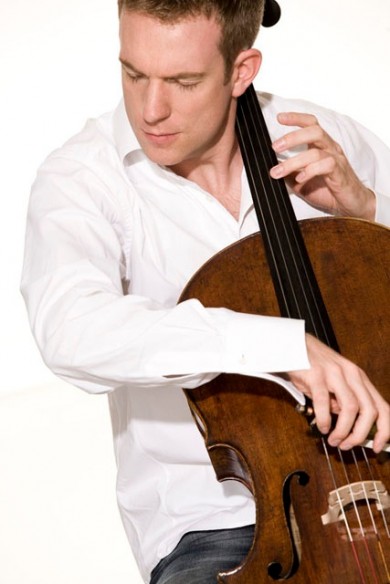Cellist Moser lifts uneven Dresden Philharmonic concert

Cellist Johannes Moser performed music of Tchaikovsky and John Williams Monday night with the Dresden Philharmonic Orchestra at the Kravis Center.
The Dresden Philharmonic Orchestra was the marquee attraction at West Palm Beach’s Kravis Center on Monday night but soloist Johannes Moser gave the evening’s best performances and offered an unfamiliar version of a beloved classic for cello and orchestra.
Even in major cities, the quality of European orchestras can vary widely. The Dresden ensemble is a second-tier group at best, lacking the corporate polish of the Berlin Philharmonic, Munich’s Bavarian Radio Symphony, the major London orchestras or Dresden’s own Staatskapelle. Despite a fine string section, the orchestra’s winds and brass were consistently poorly balanced and there were numerous solo and ensemble gaffes.
Michael Sanderling, one of the sons of legendary German conductor Kurt Sanderling, has been this orchestra’s principal podium maestro since 2011. His music-making proved uneven. The opening movement of Brahms’ Symphony No. 4 in E minor was weighty, the tempos very slow and the Andante moderato came off as plodding rather than lyrical. Brass playing was coarse and, in the hard-driven third movement Allegro giocoso, sometimes harsh.
Only in the final passacaglia did Sanderling seem to pull the performance and orchestra together. The initial theme was stated with urgency and he maintained the tension and forward motion through the final bars. Even the ensemble’s principal flute, whose playing had been unreliable through much of the concert, articulated her big solo with accuracy and rounded tone.
Sanderling’s encore was the finale of Rossini’s William Tell Overture rather than the entire work. His tempo in this crowd pleaser was too slow, the speed up at the end an ungainly switch of gears.
Moser, a young and already internationally acclaimed cellist, was soloist in scores by John Williams and Tchaikovsky on the concert’s first half.
A suite of three pieces from Williams’ score for the 2005 film Memories of a Geisha had originally been arranged for Yo-Yo Ma. Williiams’ pseudo-Oriental effects and catchy rhythms are in the best Hollywood technicolor tradition and his signature brass fanfares inevitably make an appearance. “Sayuri’s Theme,” the opening section, bring the score’s best moments with long, arching lines on solo cello. Despite some colorful percussion writing, the piece is not very substantial as a concert work.
Although he does not possess a large tonal sonority, Moser is an aristocrat of the cello. He carries a musical line on a thin thread of tone, always phrasing with grace and sensitivity. Moser can also play rapid passages with accuracy and near perfect intonation. In a previous South Florida appearance, he gave an outstanding performance of Dvorák’s Cello Concerto with the New World Symphony under Manfred Honeck in 2011.
Tchaikovsky’s Variations on a Rococo Theme is a cello classic but the version that is usually heard is not Tchaikovsky’s original score. The score was written for German cellist Wilhelm Fitzenhagen, a professor at the Moscow Conservatory and himself a composer. Tchaikovsky consulted Fitzenhagen about writing for the instrument during composition. The completed score did not meet with Fitzenhagen’s approval so he eventually changed the order of the variations, rewrote some of the solo part and omitted Tchaikovsky’s original finale. His version was published with Tchaikovsky’s grudging approval and has become the standard version that most cellist perform. Tchaikovsky’s original score was rediscovered in the 1940’s and a few cellists have played and recorded it.
Moser has been playing the original version and his performance was a revelation. The work has a more Russian character in Tchaikovsky’s first conception. While Fitzenhagen’s version is smoother and more conventional, the original has greater swings of mood, the solo part at times more difficult. The cadenza comes early in the work and the finale of Fitzenhagen’s score makes its appearance midway through. There are interesting accents and flourishes in the solo line and wind figurations that Fitzenhagen omitted. The original final variations is very Russian and balletic. Overall, the work is less rococo and more typically Tchaikovsky.
This version deserves to be heard more often and it would be hard to imagine a better performance than Moser offered. He shaped the principal melody with restraint and the melancholy variation was understated and subtle. In the rapid-fire finale, he exhibited superb control in the instrument’s highest register.
Sanderling offered acutely sensitive support to Moser’s splendid artistry. In both the Williams and Tchaikovsky works, balances were well measured and orchestral details strongly projected. Only some raw wind playing in the Tchaikovsky proved less than ingratiating.
The Dresden Philharmonic Orchestra under Michael Sanderling plays Beethoven’s Symphony No. 7 and Tchaikovsky’s Symphony No. 5 2 p.m. Tuesday at the Kravis Center in West Palm Beach. kravis.org; 561-832-7469.
Posted in Performances
Leave a Comment
Tue Mar 3, 2015
at 2:00 pm
No Comments






